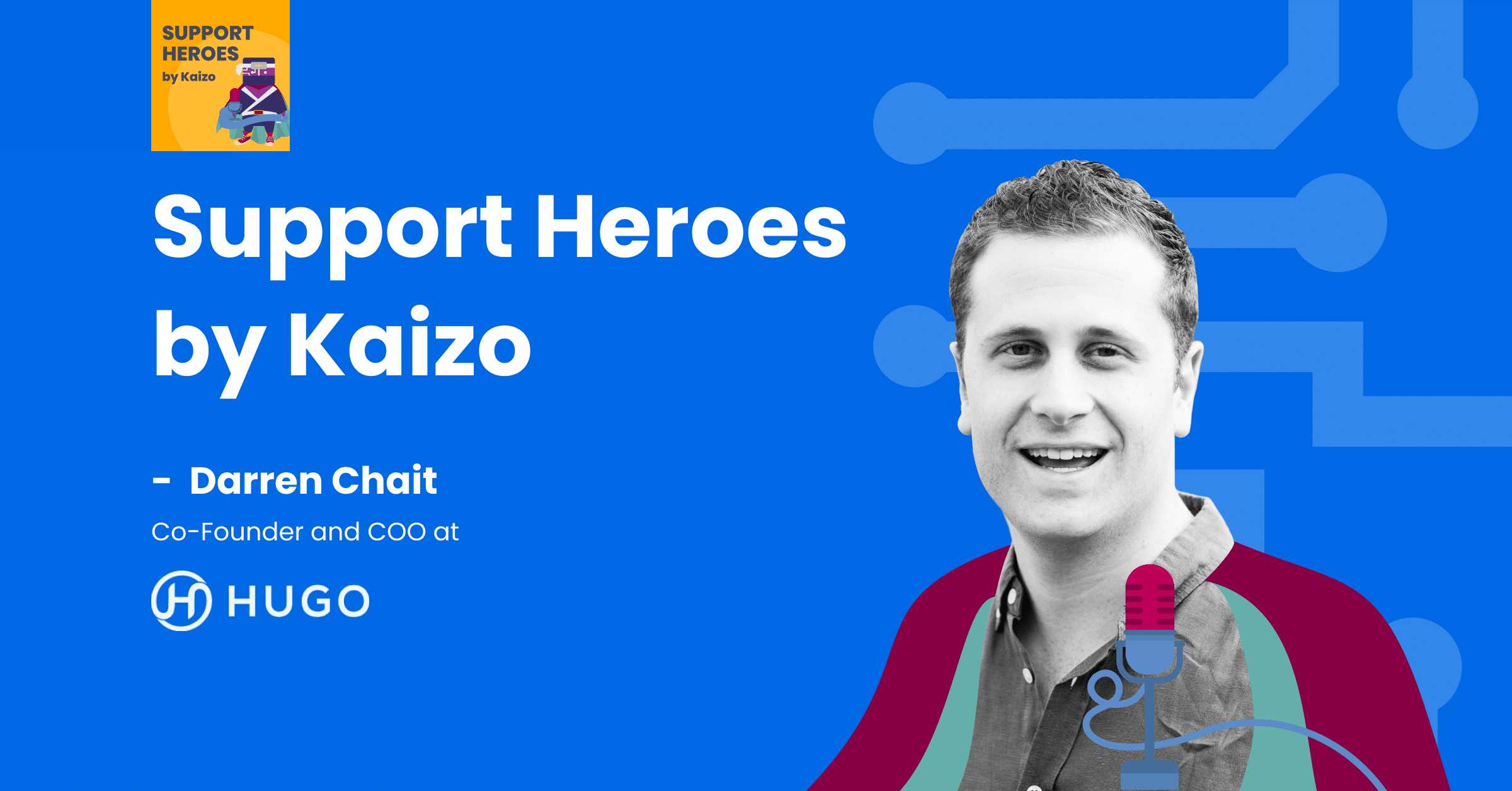Click ‘subscribe’ in the bottom right of the player to listen or download from Apple Podcast, Spotify, Google Podcast, and Amazon Music.
The thirty-fifth episode of Support Heroes by Kaizo featured Darren Chait – Co-Founder and COO of Hugo.
In this episode, Darren describes Hugo’s unique approach that prioritised live video support above all else. Leveraging Zoom calls and pre-recorded instructional videos to create meaningful customer interactions that drive loyalty and adoption. He also describes how Hugo used technology to drive proactive video support to further skyrocket their CSAT. Hugo’s implementation of pre-recorded and live video support is truly a masterclass in creating customer delight in a cost-efficient way.
Prioritising videos over text
“We want to increase the bandwidth of our support conversations”
- Darren noted two major benefits to prioritising video support over text. The first was the “bandwidth” of communication. Bandwidth is the amount of data transmitted in a given amount of time. In a Loom video or Zoom call, much more information can be exchanged in a given amount of time versus email or live chat; especially with screen share.
- It’s far easier to understand a customer’s issue in a 1-minute Zoom call than a 1 or even 5-minute text conversation. As such, support staff at Hugo are encouraged to invite customers to impromptu video calls to understand their issues. After such a call, it’s far more likely that the support person will be able to solve the customer’s issue with one further reply because they truly understand the issue. Doing so within 2 minutes would not be possible over chat. The time saved represents the first major gain from Hugo’s prioritisation of live video support.
“The primary purpose of the call is information collection, reassuring the customer and building a relationship”
- The second major benefit that led Hugo’s founders to prioritise pre-recorded and live video support was the emotional and relational impact of meeting a member of the support team. Simply put, seeing a human face and having them be pleasant and kind over video makes a much larger impact for customers than reading text on a screen. Creating that positive emotional impact can be enough to move customers from a trial into being a full-paying customer. This represents the second major gain from Hugo’s prioritisation of live video support.
- To supplement this strategy, Hugo prioritised oral communication skills in their customer service hiring. Being more selective in this category than the average and rigorously testing to see if new employees could truly be ambassadors for the company during face-to-face customer interactions.
Strong emphasis on proactive service
- The guiding pillar in Hugo’s approach to video support is that customers who have had a support interaction have a higher net promoter score (NPS) than those that haven’t. As such, Darren and his Co-Founder at Hugo set up their strategy to maximize the number of support interactions with customers and make them as positive as possible.
- Many customers who have a bad experience don’t contact support. Some of these customers will churn and some will stay but will have a lesser opinion of the company. Hugo avoids this by proactively reaching out to customers when they encounter an error in the product. If the customer encountered a known issue, they immediately received a helpful Loom video explaining how to solve or avoid their issue. If helpful content isn’t available, the customer is offered a helpful call.
“Users that would have bounced or been frustrated, now have their experience changed into a positive one”
How is this achieved?
- An ‘analytics event’ is fired from Hugo’s ‘analytics stack’ every time a customer experiences an error in Hugo (every time the customer sees an error screen). This event links to Hugo’s email service provider and triggers an email to be sent. The email contains the data from the analytics events so it’s specific to the customer and their issue.
- If it’s a new error, the email would read: “Hi __, you got an error saying __. What were you doing at the time? I think I can help you resolve it.”
- If it’s a known error, the email would read: “Hi __, you got an error saying __. We think this Loom video will help you.”
- Hugo uses Sentry for error logging. As with their ‘analytics stack’, Sentry also links to their email service provider and triggers an email to be sent if a user-facing error is identified. The team also uses fullstory as a heat mapping tool to track user activity in their product. This software can identify ‘rage clicking’ which is also used as a prompt to reach out to a customer and provide proactive support.
- Such a response to rage clicking would read: “It looks like Hugo is being a bit frustrating right now. What can we do to help?”
But why?
“The reply rates to these messages are exceptional…the satisfaction and sentiment of these conversations is so much better than typical reactive support conversation”
- Driving such interactions hits both the goals of Hugo’s approach to customer service. It increases the number of support interactions by not relying on customers to reach out when they have an issue. The interactions are also more positive because the customer experiences less pain from issues and sees the interaction in a more positive light. Customers are impressed and grateful for the help because they haven’t even asked for it.



